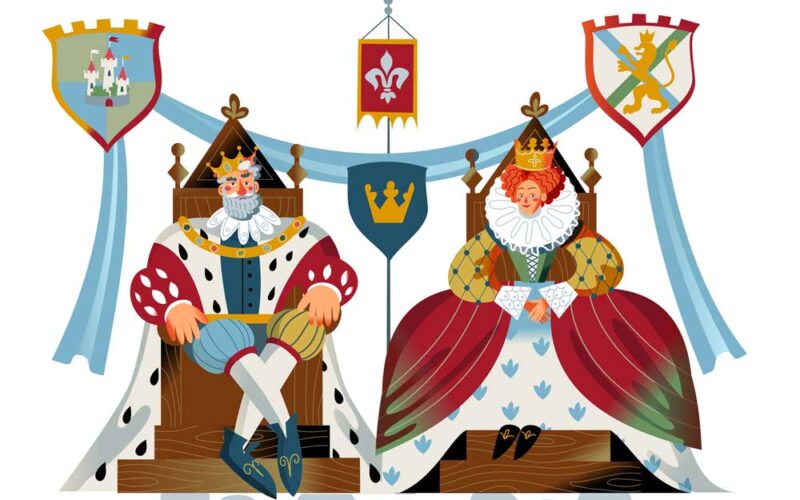What is a monarchy?
A monarchy is a system in which only one person is given the sovereignty of the state and the state is run by one person’s decision. Monarchy, generally inherited by the descendants of rulers, was the main form of government of mankind in the past. Historically, a monarchy is a political system that is much older than democracy and communism. However, as mankind developed over the years, new political systems emerged. Although monarchy remains in several countries, new political systems are now dominant. The countries currently implementing a monarchy also have different types of monarchy.
What are the different types of monarchies?
Monarchy is classified into various forms of monarchy depending on how the power of a monarch is inherited and how much power he or she has. The first type of monarchy involves the method of succession to the monarchy, which can be largely divided into two.
Hereditary monarchy – The power of a monarch is inherited through bloodline. The son or daughter of a monarch inherits power and continues to rule. If a king or a queen does not have children, they may hand over or pass the title to their brother or cousin.
Elective monarchy – This form of monarchy refers to the type that is passed on to a person elected by the country’s high officials or elite groups. One of the most representative examples of elective monarchy is the method of electing a pope who rules the Vatican.
The second method of inheritance of power, monarchy is also divided into some types according to the degree of authority held by the monarch.
Absolute monarchy – It’s the concept of a monarch ruling a country with absolute power. There are parliaments and various government agencies, but the monarch exercises the final decision-making power. Saudi Arabia is a country that has implemented an absolute monarchy until today. The Saudi royal family now rules the country with absolute power.
Constitutional monarchy – It’s a form of monarchy where a monarch has power, but is limited by law. There is a king as head of state. The prime minister, who is to engage in the country’s politics and external activities, is elected by election. Although the king has a lot of power, various legal and political factors require a compromise with the head of government to exercise power. The representative countries implementing the constitutional monarchy are the United Kingdom and Japan.
Countries with a monarchy today
Today, about 44 countries around the world have a monarchy. The power of a monarch has diversified according to the situation and times. The absolute monarchy, a system of governance that used to be dominant in the past, is now scarce and remains mostly in the Arab region. Royals who ruled the country in the past have adapted to governance systems that have changed over time. Rather than leading the country by implementing the absolute monarchy, the remaining royals have played a predominantly symbolic role today. It was the French Revolution that led to the start of the collapse of absolute monarchy in Europe. This revolution was a resistance to the absolute monarchy system. After World War I, the leaders of the defeated countries took responsibility for the war, leading to the almost complete collapse of the absolute monarchy in Europe. Later, with the creation of a constitutional monarchy, the system of a modern monarchy was established. The most representative constitutional monarchy is the United Kingdom. The sovereignty of the country is Queen Elizabeth II, but it is up to elected British parliamentarians to pass the country’s constitution and legislation. Political or administrative activities do not belong to the monarch, but they represent the state, model for the identity and unity of the state, and play a leading role in maintaining the stability and sustainability of the state.
Conclusion
For people who live in democratic countries, the concept of a king and a queen can be strange. They may be considered to be present only in fairy tales or in movies. Although existing royals are taking a very different step compared to the monarchs of the past, who ruled their countries with absolute power, they are also carrying out very important duties for their countries. In most cases, modern royal families play a role as a symbol of the country with a soft and inclusive image rather than a powerful and dignified voice. It is a very impressive fact that a monarchy and a modern system of governance are well mixed in many countries.
References
Githuri, J. (2020). All the different types of monarchy governments in place. [online] Tuko.co.ke – Kenya news. Available at: https://www.tuko.co.ke/353767-different-types-monarchy-governments.html [Accessed 18 July 2022].
Wilde, R. (2018). What Is a Monarchy? [online] ThoughtCo. Available at: https://www.thoughtco.com/what-is-a-monarchy-1221597 [Accessed 20 July 2022].
Morris, H. (2021). Does our modern world need kings and queens any more? [online] https://news-decoder.com/. Available at: https://news-decoder.com/does-our-modern-world-need-kings-and-queens-any-more/ [Accessed 19 July 2022].
Kostiner, J. (2019). monarchy | Definition, Examples, & Facts. In: Encyclopædia Britannica. [online] Available at: https://www.britannica.com/topic/monarchy [Accessed 19 July 2022].
